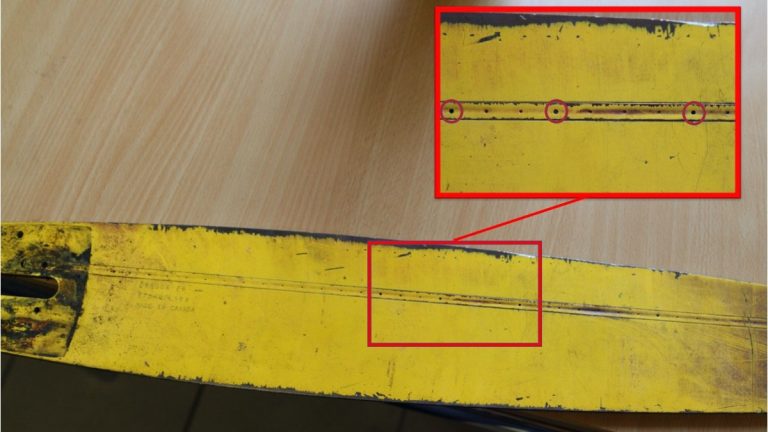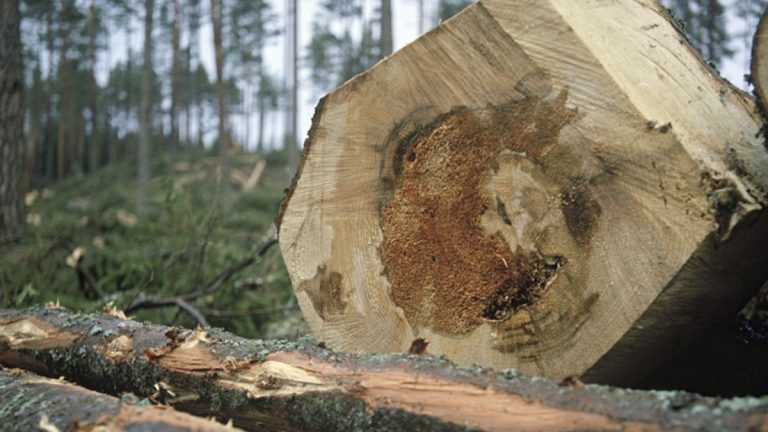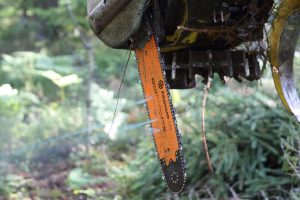The forest is under attack. Fire, floods, insects and the public would have been enough, but the most destructive enemy in the boreal and temperate conifer forests in the norther hemisphere is the fungus Heterobasidion annosum – root rot. In Sweden, 15 % of Norway spruce (Picea abies) shows signs of decay due to root rot which cause big losses for forest owners.
Photo: Skogsstyrelsen.se (Swedish Forestry Agency)
Root rot – worth fighting
It has been known since the 50’s that the root rot fungus enters the trees through “bark wounds” and stumps after felling. This knowledge made it possible to find methods to limit the damages.
Norway spruce is the most susceptible species for root rot. The main problem is that when the pest has established in a spruce stand it´s impossible to get rid of. It spreads through root-to-root contact meaning it spreads also to the next generation of trees. When it has taken over a stand there are few alternatives on what to do. In very serious cases, the Norwegian Spruce must be replaced by other species or mixed forest.
Several species of conifer can be affected by Heterobasidion annosum, but so far it´s not common in Sweden to act against it on any other species than Norwegian spruce.
The fight
To avoid damaging stems and roots of living trees is a good start to prevent the root rot from entering the trees. One can also focus on cutting in the wintertime when the fungus spores are less active.
Another way to reduce the spread of root rot is to treat the stumps with substrate during felling. At first, urea and boron were used to raise the pH value and prevent fungal spores from growing. This method was efficient and became commercial by the end of the 80’s. It was later discovered that this method had negative impact on the environment around the stumps and it was eventually forbidden in Sweden.
In the 90’s, a new method to treat the stumps was developed. In this case, spores from another fungus, the fungus Phlebiopsis gigantea, is spread on the stumps. It is a so-called saprophyte that colonizes dead wood but doesn´t damage living trees. It is also an antagonist against Heterobasidion annosum. This method doesn´t cure the root rot but it prevents it from spreading.
The Phlebiopsis gigantea is commercially available under the brand RotStop. The substrate is sprayed on to the stumps as they are being cut. If the stump is properly covered, it has been calculated that the amount of Heterobasidion annosum is almost 200 times smaller compared to untreaded stumps. Of stumps that are not treated, 80 % are infested with Heterobasidion annosum after three months. The corresponding figure for treated stumps is 30 %. However, it´s important to get a good coverage to get maximum effect, at least 85 % of the stump must be covered.
RotStop – how to get it on to the stump
Using Phlebiopsis gigantea is (in Sweden) the only approved, and most effective method for reducing the spread of root rot. The most common method to spray it on the stumps is to equip the harvester for it:
- A mixer that mixes the concentrated Phlebiopsis gigantea with water and dye (to make it visible), and of course containers for those ingredients.
- A pump that doses and brings the fluid to the harvester head.
- A special saw bar with a channel that carry the fluid and spread it over the stump each time a tree is felled. The bar has several markers where the holes could be. The operator punches or drills a suitable number of holes depending on the diameter of the trees that are to be cut. Also, the location of the holes affects the result.

Recommended number of holes in the bar is 3 – 6. The more holes the more pressure is being lost which affects the spreading capacity.
The system is mainly used in thinning of Norwegian spruce during the time when the average daily temperature is over + 5 centigrade. Some companies also use it on clear cuts. Different companies have different requirements for coverage. It varies between 85 and 95 % of the surface area of the stump. Of course, 100 % is desirable.
To be able to see the coverage of the stump, dye is added to the substrate as the Phlebiopsis gigantea is colorless. However, the substrate soon is sucked into the stump. So, when checking the coverage, one must be there within a few minutes after the tree has been cut.
The same stump with the tip of my boot as reference. The left photo is taken within a minute after the cut, the right photo 5 – 10 minutes later.
Financial losses for forest owners and for the nation
As Norwegian Spruce is the dominating tree species in Sweden, especially in the south, the Heterobasidion annosum is the single most serious threat to the forest. The warmer climate that we are experiencing, also contributes to the spreading of root rot.
The forest industry is one of Sweden’s most important sources of income, as it also is for many private forest owners. The calculated annual loss in Sweden due to root rot is approx. 1 billion SEK (Swedish Krona, approx. 108 million USD). It´s therefore essential to do whatever we can to stop it or at least reduce the effects of it.
This is a fight that will go on. It´s interesting though, that not more is being done to solve the problem. Today, Phlebiopsis gigantea seems to be the only alternative(?) apart from moving all felling of Norwegian spruce to cold winters.
Sources: Swedish University of Agricultural Sciences (SLU), Swedish Forest Agency (Skogsstyrelsen) and Wikipedia.
Photos: Per Jonsson except where otherwise stated















